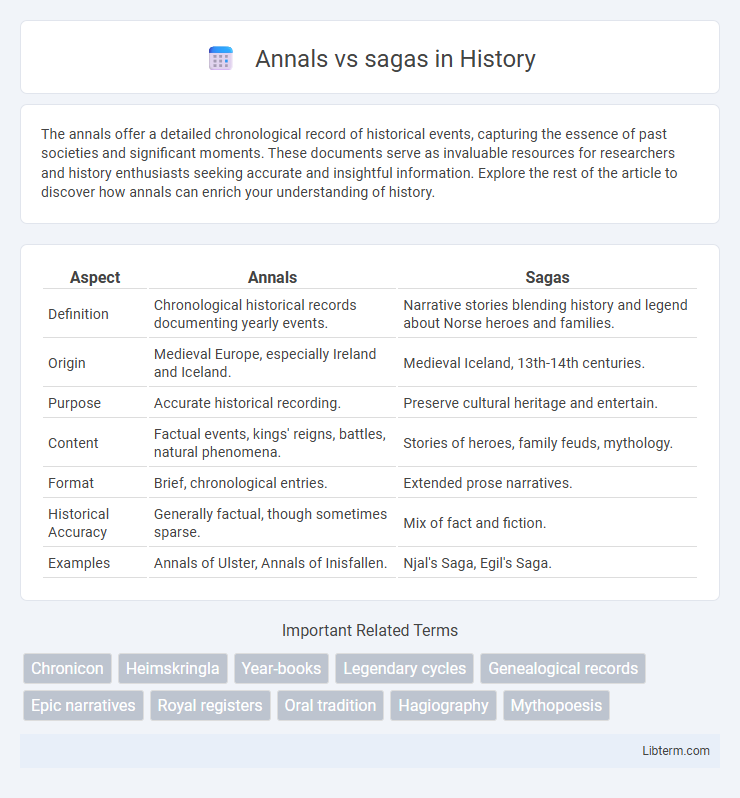The annals offer a detailed chronological record of historical events, capturing the essence of past societies and significant moments. These documents serve as invaluable resources for researchers and history enthusiasts seeking accurate and insightful information. Explore the rest of the article to discover how annals can enrich your understanding of history.
Table of Comparison
| Aspect | Annals | Sagas |
|---|---|---|
| Definition | Chronological historical records documenting yearly events. | Narrative stories blending history and legend about Norse heroes and families. |
| Origin | Medieval Europe, especially Ireland and Iceland. | Medieval Iceland, 13th-14th centuries. |
| Purpose | Accurate historical recording. | Preserve cultural heritage and entertain. |
| Content | Factual events, kings' reigns, battles, natural phenomena. | Stories of heroes, family feuds, mythology. |
| Format | Brief, chronological entries. | Extended prose narratives. |
| Historical Accuracy | Generally factual, though sometimes sparse. | Mix of fact and fiction. |
| Examples | Annals of Ulster, Annals of Inisfallen. | Njal's Saga, Egil's Saga. |
Defining Annals and Sagas
Annals are chronological records of events, typically written year-by-year, serving as concise, factual historical logs from medieval Europe. Sagas, rooted in Old Norse literature, are narrative prose works that blend history, legend, and mythology to depict heroic deeds and cultural heritage. Both formats provide valuable insights into the past but differ in structure, purpose, and storytelling style.
Historical Context and Origins
Annals are chronological records primarily developed during the early medieval period in Ireland and Continental Europe, focusing on the systematic documentation of yearly events by monastic scribes. Sagas originate from medieval Iceland and Norse culture, blending historical events with legendary narratives and oral traditions to preserve cultural identity and heroic tales. While annals emphasize factual reporting of events, sagas incorporate literary elements, reflecting contrasting historical contexts and methods of transmission.
Structure and Narrative Style
Annals feature a chronological, year-by-year structure presenting historical events in concise entries, often lacking elaborate narrative detail. Sagas employ a continuous narrative style with rich storytelling, character development, and dialogue to convey historical and legendary material. The annalistic format emphasizes factual recording, while sagas provide a more immersive and dramatized account.
Purposes and Functions
Annals serve primarily as chronological records of events, providing a year-by-year account aimed at preserving historical accuracy and official documentation. Sagas function as narrative tales that blend history with mythology, focusing on entertainment, moral lessons, and the reinforcement of social values. While annals emphasize factual precision, sagas prioritize storytelling to connect cultural identity with historical context.
Sources and Authorship
Annals are historical records typically compiled by monks or clergy who documented events year-by-year using official sources such as church documents or royal decrees. Sagas, on the other hand, are narrative prose rooted in oral tradition, often authored anonymously or by Icelandic storytellers who blended historical facts with legend. While annals prioritize chronological accuracy and factual reporting, sagas emphasize storytelling, character development, and cultural values, drawing from both memory and earlier texts.
Literary Techniques
Annals employ a chronological, factual recording style prioritizing dates and events, often with succinct, objective entries that emphasize historical accuracy. Sagas utilize narrative storytelling with rich character development, dialogue, and episodic structure, blending historical facts with mythic and legendary elements. The literary techniques in sagas include the use of irony, foreshadowing, and vivid imagery, enhancing emotional engagement compared to the annals' straightforward reportage.
Portrayal of Events and Characters
Annals provide concise, chronological records of historical events with minimal interpretation, focusing on factual accuracy and dates, which often results in a detached portrayal of characters. Sagas offer rich narrative detail and dramatized storytelling, emphasizing complex character development and moral lessons within historical or legendary contexts. The portrayal in sagas tends to be more subjective and literary, blending myth and history to enhance the cultural significance of events and personalities.
Cultural Significance
Annals and sagas both serve as crucial cultural artifacts preserving Norse history and mythology but differ in purpose and style. Annals provide concise, chronological records of historical events, emphasizing factual accuracy and political developments in medieval Scandinavia. Sagas, rich in narrative detail and character development, convey cultural values, social norms, and heroic ideals, deeply influencing Icelandic identity and medieval literature.
Examples of Famous Annals and Sagas
The Anglo-Saxon Chronicle and the Annals of Ulster serve as prominent examples of medieval annals, meticulously documenting yearly events in a concise, factual style. In contrast, the Icelandic sagas such as the Saga of Erik the Red and Njals saga provide rich narrative accounts blending history, legend, and myth to depict the lives and struggles of Norse heroes. Both annals and sagas are essential for understanding medieval history, offering complementary perspectives through their distinct literary forms.
Lasting Impact on Historical Writing
Annals provide chronological, year-by-year records that prioritize accuracy and brevity, influencing the structure of modern historiography by emphasizing precise dating. Sagas blend historical events with narrative storytelling and cultural context, shaping literary history by preserving oral traditions and offering insights into medieval Scandinavian society. Together, annals and sagas contribute to historical writing by combining factual record-keeping with rich narrative detail, enhancing both authenticity and engagement.
Annals Infographic

 libterm.com
libterm.com